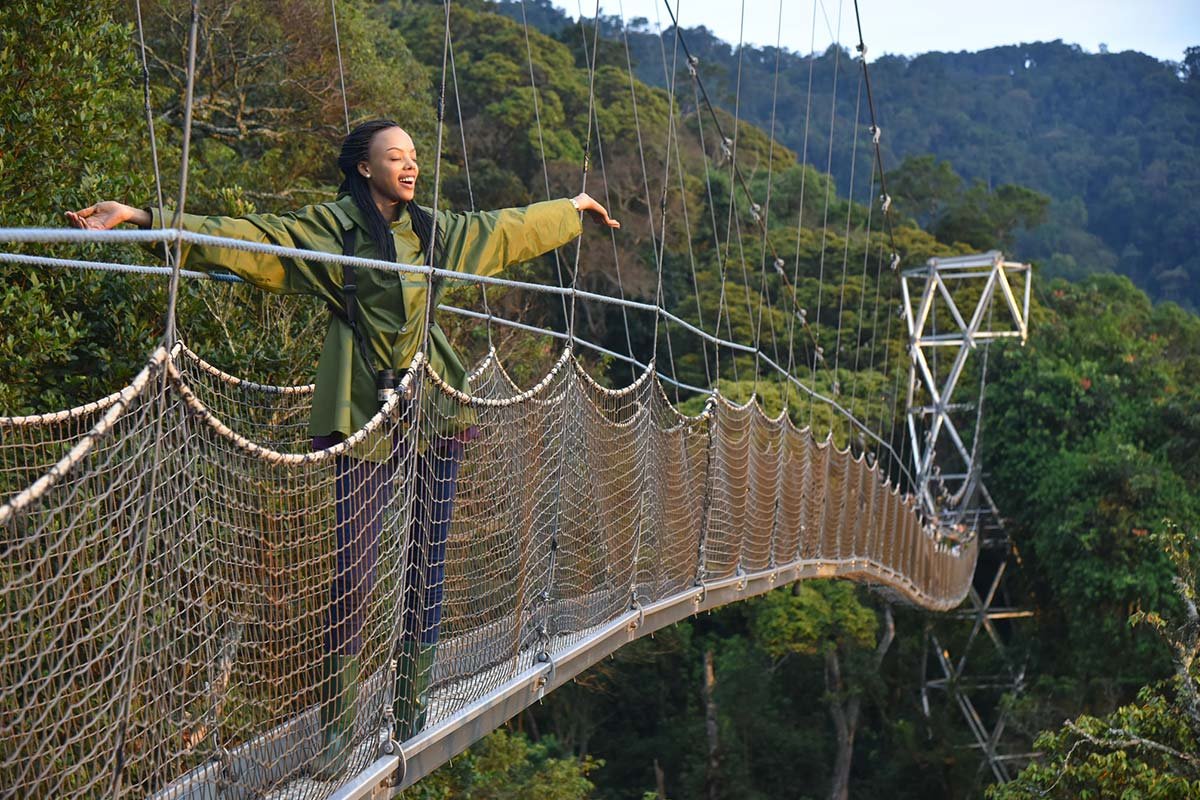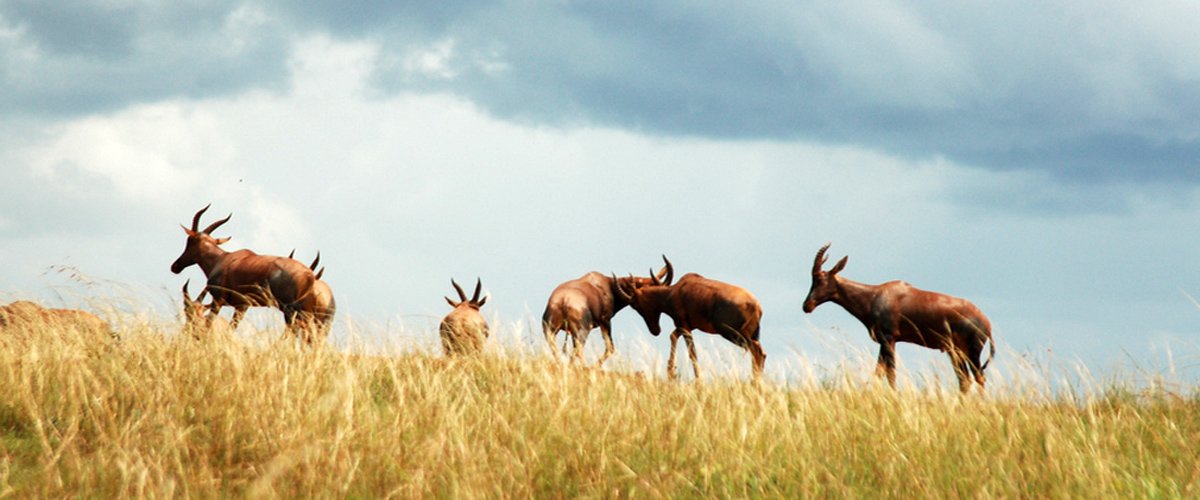Volcanoes National Park: A Majestic Realm of Fire and Life
Nestled in the northern Rwanda circuits, Volcanoes National Park stands as Africa’s premier primate safaris and eco tourism destination. Spanning 160 square kilometers, this protected area forms part of the Virunga Conservation Area,, a chain of majestic volcanic mountains shared with Uganda and the Democratic Republic of Congo.
The park’s crown jewel is its critically endangered mountain gorillas immortalized by Dian Fossey’s research in Gorillas in the Mist. Today, gorilla trekking in Rwanda experiences here offer unparalleled wildlife encounters.
From its towering volcanic peaks to its dense tropical rainforests, Volcanoes National Park offers so much more than gorilla trekking, but also golden monkey tracking, hiking Mount Bisoke, and cultural tours at Iby’Iwacu Village. It also offers visits to Karisoke Research Center, making it a must-see for nature lovers and adventure seekers alike.
Where is Volcanoes National Park?
Volcanoes National Park lies along the Virunga Mountains, a chain of eight volcanoes that straddle the borders of Rwanda, Uganda, and the Democratic Republic of Congo. Within the park’s boundaries are five of these volcanoes: Karisimbi, Bisoke, Muhabura, Gahinga, and Sabyinyo. These dormant and extinct volcanoes, some of which soar above 4,000 meters, form a dramatic landscape of rugged terrain, lush valleys, and steep slopes.

Mount Karisimbi, the tallest of the Virunga volcanoes at 4,507 meters, is a popular challenge for trekkers, offering stunning panoramic views from its summit. Nearby, Mount Bisoke boasts a beautiful crater lake at its summit, often shrouded in clouds that add to its mystique.
The volcanic soil of the region is extremely fertile, giving rise to dense montane forests that are home to a wealth of biodiversity. Though none of the volcanoes in Rwanda are currently active, their presence is a constant reminder of the tectonic activity that shaped this dramatic landscape.
Conservation and Dian Fossey’s Legacy
Volcanoes National Park is a symbol of successful conservation efforts, and much of its modern reputation is tied to the legacy of Dian Fossey. An American primatologist and conservationist, Fossey came to the Virunga Mountains in the 1960s and established the Karisoke Research Center between Mounts Karisimbi and Bisoke. Her groundbreaking work brought international attention to the plight of mountain gorillas, whose numbers were rapidly declining due to poaching, habitat loss, and civil unrest.
Fossey’s research, advocacy, and uncompromising stance against poaching laid the foundation for much of the conservation work that continues today. Though she was tragically murdered in 1985, her legacy endures through the Dian Fossey Gorilla Fund and other organizations dedicated to protecting the gorillas and their habitat. Today, anti-poaching patrols, veterinary care, community outreach, and sustainable tourism efforts help ensure that the mountain gorilla population continues to grow.
Mountain Gorillas: The Stars of Volcanoes National Park
Understanding Mountain Gorilla Families
Volcanoes National Park is home to more than ten habituated mountain gorilla families, each with its own unique dynamics and history. Habituation is a years-long process where gorillas gradually become accustomed to human presence, allowing for responsible tourism that funds conservation efforts.
Among the most notable groups are;
- Susa family, originally studied by Dian Fossey and known for having one of the largest gorilla populations. The group gained further fame through the documentary Gorillas in the Mist, which highlighted Fossey’s groundbreaking research.
- Amahoro group, whose name means “peace” in Kinyarwanda. Led by the calm and imposing silverback Ubumwe, this family is often recommended for first-time trekkers due to their relatively predictable movements.
- Hirwa group, meaning “lucky,” is another favorite, frequently observed with playful juveniles and energetic young gorillas.
- Kwitonda group is known for its migratory behavior, sometimes crossing into the Democratic Republic of Congo before returning to Rwanda’s slopes.
Each gorilla family has distinct social structures, ranging from 10 to over 20 members, including dominant silverbacks, adult females, juveniles, and adorable infants. Observing their interactions—whether during feeding, grooming, or playful wrestling—provides an unforgettable wildlife experience.
Gorilla Trekking in Volcanoes National Park
Gorilla trekking Rwanda experiences begin early each morning at the park headquarters, where tourists are briefed and assigned to one of 12 habituated gorilla groups. These groups, like the famous Susa group and the peaceful Amahoro family, offer intimate glimpses into gorilla behavior.
Treks vary in difficulty and duration, from easy 30-minute walks to challenging multi-hour climbs. Whether you’re near the park edge or deep in the jungle, the reward is unforgettable: watching a 400-pound silverback peacefully munch on bamboo, or a baby gorilla playing under its mother’s watchful eye.
Rwanda gorilla trekking permits (currently $1,500 USD) are limited—book early with trusted operators.
When to Visit Volcanoes National Park
The best times for gorilla trekking in Rwanda are during the dry seasons:
- June to September
- December to February
These months offer clearer trails and better visibility. However, visiting during the wet seasons (March–May, October–November) means fewer tourists, vibrant vegetation, and a higher chance of gorilla sightings closer to the park edge. April and November see the heaviest rains, potentially disrupting hikes.
What to Pack for Gorilla Trekking
Prepare well for your gorilla trek with this Rwanda gorilla trekking packing list:
- Waterproof hiking boots (broken-in)
- Lightweight waterproof jacket & pants
- Long sleeves and trousers (protection from stinging nettles)
- Gardening gloves (for vegetation)
- Insect repellent
- Daypack with water/snacks
- Camera (no flash) and extra batteries
Beyond Gorillas: Other Park Activities
While gorillas are the main attraction, Volcanoes National Park offers several other incredible experiences. Golden monkey trekking provides the chance to observe these playful, endangered primates with their striking orange-gold fur. The park is also a hiker’s paradise, with trails leading up several volcanoes including Mount Bisoke Hike (known for its beautiful crater lake) and Mount Karisimbi Hike (requiring an overnight camping trip).
For those interested in conservation history, a visit to the Karisoke Research Center offers fascinating insights into Dian Fossey’s work and ongoing gorilla protection efforts. Cultural experiences at the nearby Iby’Iwacu Village allow visitors to connect with local communities and learn about traditional Rwandan life.
Challenges and the Future Volcanoes National Park
Despite its success, Volcanoes National Park faces ongoing challenges. Population pressure, agricultural encroachment, poaching, and climate change continue to threaten the park’s ecosystems. As Rwanda’s population grows, balancing conservation with human development is a constant struggle. Initiatives such as community-based tourism, reforestation projects, and educational programs are critical to keeping harmony between the park and the people who live around it.
The Rwandan government has also announced plans to expand the park’s boundaries by 10,000 hectares, a move designed to protect gorilla habitat and reduce human-wildlife conflict. This expansion will include reforestation, buffer zones, and new tourism infrastructure—all aimed at ensuring the long-term sustainability of the park.
Moreover, ongoing collaboration between governmental bodies, NGOs, scientists, and local communities is essential to maintaining the park’s integrity. International support remains crucial, both in terms of funding and policy advocacy, especially as conservation increasingly intersects with issues like poverty alleviation, health, and climate resilience.
Final Thoughts: Rwanda’s Primate Paradise
From primate safaris to high-altitude hikes in Africa, Volcanoes National Park Rwanda delivers a deeply personal and meaningful connection to nature. Whether you’re exploring Gorillas in the Mist film locations, hiking volcanic slopes, or learning from local communities, this destination blends wildlife, adventure, and culture in perfect harmony.
Add it to your Rwanda safari itinerary—because the magic of Volcanoes NP isn’t just in seeing gorillas. It’s in feeling part of something bigger.


